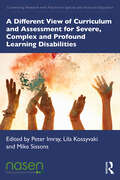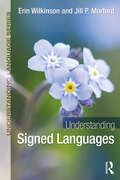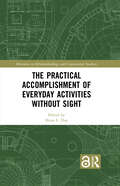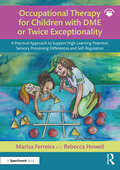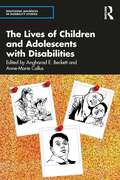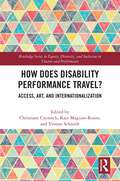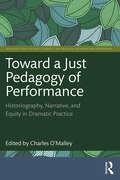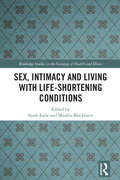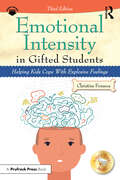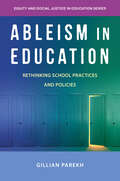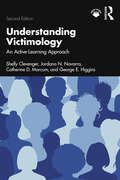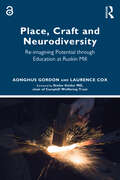- Table View
- List View
A Different View of Curriculum and Assessment for Severe, Complex and Profound Learning Disabilities (Connecting Research with Practice in Special and Inclusive Education)
A Different View of Curriculum and Assessment links a theoretical pedagogical model with a sympathetic practical model of curriculum and assessment difference for those with PMLD, CLD and SLD. Split into two parts, this accessible resource combines theoretical explanations with first-hand accounts of how this works in educational establishments, through the analysis of evidence-based practice carried out in a number of English special (specialist) schools. The expert authors challenge the notion that a national, or common core standards, curriculum, however expertly differentiated, is fit-for-purpose for the PMLD, CLD and SLD populations in any country. A Different View offers cogent and reasoned arguments for considering that irrespective of age, such learners learn differently to their neuro-typical, conventionally developing peers. If they learn differently, this book shows how we should be teaching them differently. Reflecting the centrality of process over product, this book will clearly explain how each individual learner might be enabled and facilitated to become the best they can be and do the best they can do, in order to fully realise their potential as equal and independent citizens.
A Different View of Curriculum and Assessment for Severe, Complex and Profound Learning Disabilities (Connecting Research with Practice in Special and Inclusive Education)
by Peter Imray Lila Kossyvaki Mike SissonsA Different View of Curriculum and Assessment links a theoretical pedagogical model with a sympathetic practical model of curriculum and assessment difference for those with PMLD, CLD and SLD. Split into two parts, this accessible resource combines theoretical explanations with first-hand accounts of how this works in educational establishments, through the analysis of evidence-based practice carried out in a number of English special (specialist) schools. The expert authors challenge the notion that a national, or common core standards, curriculum, however expertly differentiated, is fit-for-purpose for the PMLD, CLD and SLD populations in any country. A Different View offers cogent and reasoned arguments for considering that irrespective of age, such learners learn differently to their neuro-typical, conventionally developing peers. If they learn differently, this book shows how we should be teaching them differently. Reflecting the centrality of process over product, this book will clearly explain how each individual learner might be enabled and facilitated to become the best they can be and do the best they can do, in order to fully realise their potential as equal and independent citizens.
Anomia: Theoretical and Clinical Aspects (Brain, Behaviour and Cognition)
by Matti Laine Nadine MartinThis important book provides a broad, integrated overview of current research on word-finding deficit, anomia, the most common symptom of language dysfunction occurring after brain damage. Besides its clinical importance, anomia gives a fascinating view on the inner workings of language in the brain. Written by two internationally known researchers in the field, the book begins with an overview of psycholinguistic research on normal word retrieval as well as the influential cognitive models of naming and goes on to review the major forms of anomia. Neuroanatomical aspects, clinical assessment and therapeutic approaches are reviewed and evaluated. This edition has been fully updated to include coverage of advances in cognitive modeling of lexical retrieval disorders, structural and functional neuroimaging findings on the neural basis of naming and anomia, anomia diagnostics and new approaches to the challenging task of anomia therapy. Covering both theory and practice, this book provides invaluable reading for researchers and practitioners in speech and language disorders, neuropsychology and neurology, as well as for advanced undergraduate students and graduate students in the field.
Anomia: Theoretical and Clinical Aspects (Brain, Behaviour and Cognition)
by Matti Laine Nadine MartinThis important book provides a broad, integrated overview of current research on word-finding deficit, anomia, the most common symptom of language dysfunction occurring after brain damage. Besides its clinical importance, anomia gives a fascinating view on the inner workings of language in the brain. Written by two internationally known researchers in the field, the book begins with an overview of psycholinguistic research on normal word retrieval as well as the influential cognitive models of naming and goes on to review the major forms of anomia. Neuroanatomical aspects, clinical assessment and therapeutic approaches are reviewed and evaluated. This edition has been fully updated to include coverage of advances in cognitive modeling of lexical retrieval disorders, structural and functional neuroimaging findings on the neural basis of naming and anomia, anomia diagnostics and new approaches to the challenging task of anomia therapy. Covering both theory and practice, this book provides invaluable reading for researchers and practitioners in speech and language disorders, neuropsychology and neurology, as well as for advanced undergraduate students and graduate students in the field.
Understanding Signed Languages (Understanding Language)
by Erin Wilkinson Jill P. MorfordUnderstanding Signed Languages provides a broad and accessible introduction to the science of language, with evidence drawn from signed languages around the world. Readers will learn about language through a unique set of signed language studies that will surprise them with the diversity of ways human languages achieve the same functional goals of communication. Designed for students with no prior knowledge of signed languages or linguistics, this book features: A comprehensive introduction to the sub-fields of linguistics, including sociolinguistics, linguistic structure, language change, language acquisition, and bilingualism; Examples from more than 50 of the world’s signed languages and a brief “Language in Community” snapshot in each chapter highlighting one signed language and the researchers who are documenting it; Opportunities to reflect on how language ideologies have shaped scientific inquiry and contributed to linguistic bias; Review and discussion questions, useful websites, and pointers to additional readings and resources at the end of each chapter. Understanding Signed Languages provides instructors with a primary or secondary text to enliven the discourse in introductory classes in linguistics, interpreting, deaf education, disability studies, cognitive science, human diversity, and communication sciences and disorders. Students will develop an appreciation for the language-specific and universal characteristics of signed languages and the global communities in which they emerge.
Understanding Signed Languages (Understanding Language)
by Erin Wilkinson Jill P. MorfordUnderstanding Signed Languages provides a broad and accessible introduction to the science of language, with evidence drawn from signed languages around the world. Readers will learn about language through a unique set of signed language studies that will surprise them with the diversity of ways human languages achieve the same functional goals of communication. Designed for students with no prior knowledge of signed languages or linguistics, this book features: A comprehensive introduction to the sub-fields of linguistics, including sociolinguistics, linguistic structure, language change, language acquisition, and bilingualism; Examples from more than 50 of the world’s signed languages and a brief “Language in Community” snapshot in each chapter highlighting one signed language and the researchers who are documenting it; Opportunities to reflect on how language ideologies have shaped scientific inquiry and contributed to linguistic bias; Review and discussion questions, useful websites, and pointers to additional readings and resources at the end of each chapter. Understanding Signed Languages provides instructors with a primary or secondary text to enliven the discourse in introductory classes in linguistics, interpreting, deaf education, disability studies, cognitive science, human diversity, and communication sciences and disorders. Students will develop an appreciation for the language-specific and universal characteristics of signed languages and the global communities in which they emerge.
The Practical Accomplishment of Everyday Activities Without Sight (ISSN)
by Brian L. DueThis book is about the everyday life of people with visual impairment or blindness. Using video ethnographic methods and ethnomethodological conversation analysis, it unpacks the practical accomplishments of everyday activities such as navigating in public space, identifying objects and obstacles, being included in workplace activities, interacting with guide dogs, or interacting in museums or classes in school.Navigation, social inclusion, and the world of touch constitute key phenomena that are affected by visual impairment and which we study in this book. Whereas sighted people use their sight for navigating, for figuring out the location of co-participants and the embodied cues they produce, and for achieving understanding of objects in the world, visually impaired people on the contrary cannot rely on vision for navigating, for interpreting embodied cues, or for identifying or recognizing objects. Other sensory resources and other practices are employed to accomplish these basic human actions. The chapters in this book present examples and findings relevant to these issues and draw out the general theoretical implications of these findings. Whereas existing research often studies visual impairment from a medical, cognitive, and psychological perspective, this book provides insights into how visually impaired people accomplish ordinary activities in orderly, organized ways by a detailed study of their actions. While most books describe cognitive and biological issues, many of them using experimental methods, this book provides empirical findings about the actual daily lives as it naturally unfolds based on video recordings. The book contributes insights into the practices of living with visual impairment as well as perspectives for rethinking some of the most basic aspects of human sociality, including perception, interaction, multisensoriality and ocularcentrism (the view that the world is de facto designed by and for sighted persons). As such, the book provides novel findings in the field of ethnomethodological conversation analysis.Renewing the social model of disability, this book will appeal to scholars of sociology with interests in ethnomethodology and conversation analysis, the emergence of practical skills, and understandings of disability in terms of relations between the individual and the social environment.Chapter 1 of this book is freely available as a downloadable Open Access PDF at http://www.taylorfrancis.com under a Creative Commons [Attribution-Non Commercial-No Derivatives (CC-BY-NC-ND)] 4.0 license.
The Practical Accomplishment of Everyday Activities Without Sight (ISSN)
by Brian L. DueThis book is about the everyday life of people with visual impairment or blindness. Using video ethnographic methods and ethnomethodological conversation analysis, it unpacks the practical accomplishments of everyday activities such as navigating in public space, identifying objects and obstacles, being included in workplace activities, interacting with guide dogs, or interacting in museums or classes in school.Navigation, social inclusion, and the world of touch constitute key phenomena that are affected by visual impairment and which we study in this book. Whereas sighted people use their sight for navigating, for figuring out the location of co-participants and the embodied cues they produce, and for achieving understanding of objects in the world, visually impaired people on the contrary cannot rely on vision for navigating, for interpreting embodied cues, or for identifying or recognizing objects. Other sensory resources and other practices are employed to accomplish these basic human actions. The chapters in this book present examples and findings relevant to these issues and draw out the general theoretical implications of these findings. Whereas existing research often studies visual impairment from a medical, cognitive, and psychological perspective, this book provides insights into how visually impaired people accomplish ordinary activities in orderly, organized ways by a detailed study of their actions. While most books describe cognitive and biological issues, many of them using experimental methods, this book provides empirical findings about the actual daily lives as it naturally unfolds based on video recordings. The book contributes insights into the practices of living with visual impairment as well as perspectives for rethinking some of the most basic aspects of human sociality, including perception, interaction, multisensoriality and ocularcentrism (the view that the world is de facto designed by and for sighted persons). As such, the book provides novel findings in the field of ethnomethodological conversation analysis.Renewing the social model of disability, this book will appeal to scholars of sociology with interests in ethnomethodology and conversation analysis, the emergence of practical skills, and understandings of disability in terms of relations between the individual and the social environment.Chapter 1 of this book is freely available as a downloadable Open Access PDF at http://www.taylorfrancis.com under a Creative Commons [Attribution-Non Commercial-No Derivatives (CC-BY-NC-ND)] 4.0 license.
Occupational Therapy for Children with DME or Twice Exceptionality: A Practical Approach to Support High Learning Potential, Sensory Processing Differences and Self-Regulation
by Mariza Ferreira Rebecca HowellChildren with high learning potential or giftedness have remarkable potential. Despite this, these children can struggle to participate in everyday life because of a range of needs that are sometimes misunderstood, overlooked or not adequately addressed, leading to underachievement and, in turn, low self-esteem. Needs that, in many cases, paediatric occupational therapists are best suited to address. The practical resource offered in the book, the DME-C approach, is a tried-and-tested approach to help children who have challenges relating to their high learning potential, as well as sensory processing differences, unhelpful thought patterns and self-regulation. It draws on the heart of occupational therapy that considers the whole profile of the child, actively caters to the unique profiles of children with dual or multiple exceptionality (DME) or twice exceptionality (2e), and guides therapists towards therapy provision that is strengths-based and achieves favourable outcomes. This book: ● Includes a clear and comprehensive introduction to high learning potential and DME or twice exceptionality (2e), along with guidance to help identify children with these profiles. ● Covers questions and concerns occupational therapists may have when working with children with DME or 2e. ● Considers the similarities and differences between high learning potential/DME/2e and neurodivergent conditions such as developmental coordination disorder, autism and ADHD, with a focus on sensory processing differences. ● Explains, in easy-to-understand language, the full DME-C therapy approach, with a range of example activities to use in therapy to achieve its principles, and a suggested therapy progression plan. ● Is packed full of real-life case studies to translate theory into practice. ● Empowers therapists and educational professionals further by drawing attention to how they can better relate to children with DME/2e in therapy regardless of the children’s specific needs. Full of examples and with the voices of parents and children at its heart, this resource is essential reading for occupational therapists, SENCOs, education psychologists and other relevant professionals, who want to improve the lives and wellbeing of children with DME or twice exceptionality and help them reach their full potential.
Occupational Therapy for Children with DME or Twice Exceptionality: A Practical Approach to Support High Learning Potential, Sensory Processing Differences and Self-Regulation
by Mariza Ferreira Rebecca HowellChildren with high learning potential or giftedness have remarkable potential. Despite this, these children can struggle to participate in everyday life because of a range of needs that are sometimes misunderstood, overlooked or not adequately addressed, leading to underachievement and, in turn, low self-esteem. Needs that, in many cases, paediatric occupational therapists are best suited to address. The practical resource offered in the book, the DME-C approach, is a tried-and-tested approach to help children who have challenges relating to their high learning potential, as well as sensory processing differences, unhelpful thought patterns and self-regulation. It draws on the heart of occupational therapy that considers the whole profile of the child, actively caters to the unique profiles of children with dual or multiple exceptionality (DME) or twice exceptionality (2e), and guides therapists towards therapy provision that is strengths-based and achieves favourable outcomes. This book: ● Includes a clear and comprehensive introduction to high learning potential and DME or twice exceptionality (2e), along with guidance to help identify children with these profiles. ● Covers questions and concerns occupational therapists may have when working with children with DME or 2e. ● Considers the similarities and differences between high learning potential/DME/2e and neurodivergent conditions such as developmental coordination disorder, autism and ADHD, with a focus on sensory processing differences. ● Explains, in easy-to-understand language, the full DME-C therapy approach, with a range of example activities to use in therapy to achieve its principles, and a suggested therapy progression plan. ● Is packed full of real-life case studies to translate theory into practice. ● Empowers therapists and educational professionals further by drawing attention to how they can better relate to children with DME/2e in therapy regardless of the children’s specific needs. Full of examples and with the voices of parents and children at its heart, this resource is essential reading for occupational therapists, SENCOs, education psychologists and other relevant professionals, who want to improve the lives and wellbeing of children with DME or twice exceptionality and help them reach their full potential.
The Lives of Children and Adolescents with Disabilities (Routledge Advances in Disability Studies)
This book will be of interest to undergraduates, postgraduates and researchers in disability studies, childhood studies, medicine and health sciences, and sociology. It also provides insights that will be of use and value to professionals working with disabled children and adolescents in education, health and in disability-specific services. Opening with four narratives that offer the reader a window into the lived experience of disabled children, adolescents and their families, subsequent chapters explore a range of issues facing disabled children from early childhood through to late adolescence. Topics include family life, early intervention, inclusive and post-secondary education, the right to play, digital participation, the effects of labelling and matters relating to agency and sexuality. With chapters discussing research from Australia, Canada, Ireland, Italy, Malta, Mexico, New Zealand, Sweden and the UK amongst others, this book: • contributes to the existing body of knowledge about the lives of disabled children and adolescents, with a focus on socially created disabling factors; • provides the reader with analysis of issues affecting disabled children and adolescents according to different conceptual frameworks, national contexts and with regard to different types of impairments/disabilities; • highlights the main issues that confront disabled children and adolescents, their families and their allies in the early twenty-first century;• highlights the importance of actively listening to the perspectives of disabled children and adolescents. It provides a rich source of knowledge and information about the lives of disabled children and adolescents, and a variety of perspectives on how their lives are affected by material and non-material factors, social structures and cultural constructions.
The Lives of Children and Adolescents with Disabilities (Routledge Advances in Disability Studies)
by Angharad E. BeckettThis book will be of interest to undergraduates, postgraduates and researchers in disability studies, childhood studies, medicine and health sciences, and sociology. It also provides insights that will be of use and value to professionals working with disabled children and adolescents in education, health and in disability-specific services. Opening with four narratives that offer the reader a window into the lived experience of disabled children, adolescents and their families, subsequent chapters explore a range of issues facing disabled children from early childhood through to late adolescence. Topics include family life, early intervention, inclusive and post-secondary education, the right to play, digital participation, the effects of labelling and matters relating to agency and sexuality. With chapters discussing research from Australia, Canada, Ireland, Italy, Malta, Mexico, New Zealand, Sweden and the UK amongst others, this book: • contributes to the existing body of knowledge about the lives of disabled children and adolescents, with a focus on socially created disabling factors; • provides the reader with analysis of issues affecting disabled children and adolescents according to different conceptual frameworks, national contexts and with regard to different types of impairments/disabilities; • highlights the main issues that confront disabled children and adolescents, their families and their allies in the early twenty-first century;• highlights the importance of actively listening to the perspectives of disabled children and adolescents. It provides a rich source of knowledge and information about the lives of disabled children and adolescents, and a variety of perspectives on how their lives are affected by material and non-material factors, social structures and cultural constructions.
How Does Disability Performance Travel?: Access, Art, and Internationalization (Routledge Series in Equity, Diversity, and Inclusion in Theatre and Performance)
This edited collection investigates the myriad ways in which disability performance travels in a globalized world. Disability arts festivals are growing in different parts of the world; theatre and dance companies with disabled artists are increasingly touring and collaborating with international partners. At the same time, theatre spaces are often not accessible, and the necessity of mobility excludes some disabled artists from being part of an international disability arts community. How does disability performance travel, who does not travel – and why? What is the role of funding and producing structures, disability arts festivals and networks around the world? How do the logics of international (co-)producing govern the way in which disability art is represented internationally? Who is excluded from being part of a touring theatre or dance company, and how can festivals, conferences, and other agents of a growing disability culture create other forms of participation, which are not limited to physical co-presence? This study will contextualize disability aesthetics, arts, media, and culture in a global frame, yet firmly rooted in its smaller national, state, and local community settings and will be of great interest to students and scholars in the field.
How Does Disability Performance Travel?: Access, Art, and Internationalization (Routledge Series in Equity, Diversity, and Inclusion in Theatre and Performance)
by Christiane Czymoch Kate Maguire-Rosier Yvonne SchmidtThis edited collection investigates the myriad ways in which disability performance travels in a globalized world. Disability arts festivals are growing in different parts of the world; theatre and dance companies with disabled artists are increasingly touring and collaborating with international partners. At the same time, theatre spaces are often not accessible, and the necessity of mobility excludes some disabled artists from being part of an international disability arts community. How does disability performance travel, who does not travel – and why? What is the role of funding and producing structures, disability arts festivals and networks around the world? How do the logics of international (co-)producing govern the way in which disability art is represented internationally? Who is excluded from being part of a touring theatre or dance company, and how can festivals, conferences, and other agents of a growing disability culture create other forms of participation, which are not limited to physical co-presence? This study will contextualize disability aesthetics, arts, media, and culture in a global frame, yet firmly rooted in its smaller national, state, and local community settings and will be of great interest to students and scholars in the field.
Toward A Just Pedagogy Of Performance: Historiography, Narrative, And Equity In Dramatic Practice (Routledge Series in Equity, Diversity, and Inclusion in Theatre and Performance)
This book is a compendium of resources largely by and for artists and scholars interested in engaging in conversations of justice, diversity, and historiography in the fields of theatre and performance studies. For these students, and for the future instructors in our field who will use this book, we hold a tripartite hope: to expand, to enable, and to provide access. In its whole, we intend for this book to provoke its readers to question the narratives of history that they’ve received (and that they may promulgate) in their artistic and scholarly work. We aim to question methods and ethics of reading present in the western mode of studying drama and performance history. The contributions in the book—not traditional chapters, but manifestos, experiences, articles, conversations, and provocations—raise questions and illuminate gaps, and they do not speak in a unified voice or from a static position. These pieces are written by artists, graduate students, teachers, administrators, and undergraduates; these are expressions of hope and of experience, and not of dogma. This book is aimed toward instructors of undergraduates, both graduate students and faculty at all levels of seniority within theatre and performance studies, as well as at artists and practitioners of the art that wish to find more just ways of viewing history.
Toward A Just Pedagogy Of Performance: Historiography, Narrative, And Equity In Dramatic Practice (Routledge Series in Equity, Diversity, and Inclusion in Theatre and Performance)
by Charles O’MalleyThis book is a compendium of resources largely by and for artists and scholars interested in engaging in conversations of justice, diversity, and historiography in the fields of theatre and performance studies. For these students, and for the future instructors in our field who will use this book, we hold a tripartite hope: to expand, to enable, and to provide access. In its whole, we intend for this book to provoke its readers to question the narratives of history that they’ve received (and that they may promulgate) in their artistic and scholarly work. We aim to question methods and ethics of reading present in the western mode of studying drama and performance history. The contributions in the book—not traditional chapters, but manifestos, experiences, articles, conversations, and provocations—raise questions and illuminate gaps, and they do not speak in a unified voice or from a static position. These pieces are written by artists, graduate students, teachers, administrators, and undergraduates; these are expressions of hope and of experience, and not of dogma. This book is aimed toward instructors of undergraduates, both graduate students and faculty at all levels of seniority within theatre and performance studies, as well as at artists and practitioners of the art that wish to find more just ways of viewing history.
Sex, Intimacy and Living with Life-Shortening Conditions
This multi-disciplinary and inclusive collection brings together theoretically informed and empirically focused research on sex, intimacy and reproduction in relation to young people and adults with life-shortening conditions. Advances in healthcare mean that increasing numbers of young people with life-shortening conditions are transitioning into adulthood. Issues such as sex and intimacy, dating and relationships, fertility and having children are increasingly relevant to them and to the people that support them, including families, carers, practitioners and professional education, health and social care agencies. This three-part book explores the relevance and significance of this field, examines everyday experiences, and highlights the challenges faced by individuals and organisations in addressing the needs of such people in daily life and in the context of practice. Drawing on perspectives from sociology, disability studies, epidemiology, health policy, psychotherapy, legal studies, queer studies and nursing, this ground-breaking volume is written by academics, policy makers, practitioners and experts by experience. It is an essential read for all those practising and researching in the fields of sexuality, chronic illness and disability and transition.
Sex, Intimacy and Living with Life-Shortening Conditions
by Sarah Earle Maddie BlackburnThis multi-disciplinary and inclusive collection brings together theoretically informed and empirically focused research on sex, intimacy and reproduction in relation to young people and adults with life-shortening conditions. Advances in healthcare mean that increasing numbers of young people with life-shortening conditions are transitioning into adulthood. Issues such as sex and intimacy, dating and relationships, fertility and having children are increasingly relevant to them and to the people that support them, including families, carers, practitioners and professional education, health and social care agencies. This three-part book explores the relevance and significance of this field, examines everyday experiences, and highlights the challenges faced by individuals and organisations in addressing the needs of such people in daily life and in the context of practice. Drawing on perspectives from sociology, disability studies, epidemiology, health policy, psychotherapy, legal studies, queer studies and nursing, this ground-breaking volume is written by academics, policy makers, practitioners and experts by experience. It is an essential read for all those practising and researching in the fields of sexuality, chronic illness and disability and transition.
Emotional Intensity in Gifted Students: Helping Kids Cope With Explosive Feelings
by Christine FonsecaTeaching children how to manage their intense emotions is one of the most difficult aspects of parenting or educating gifted children. Emotional Intensity in Gifted Students is an indispensable resource for parents and educators seeking to understand why gifted children can be so extreme in their behavior and how to manage the highs and lows that accompany emotional intensity. Presented in an easy-to-read, conversational style, this revised and updated third edition pulls from contemporary research to depict changes in how we understand and support gifted children as well as an increased understanding of trauma, social-emotional learning, and empathy development. Chapters feature role-plays and strategies designed to show parents and teachers how to interact and guide gifted children in a way that teaches them how to recognize, monitor, and adjust their behavior. Also featuring updated resources, worksheets, and checklists, this practical new edition is a must-read for anyone wishing to make a positive and lasting impact on the lives of gifted children.
Emotional Intensity in Gifted Students: Helping Kids Cope With Explosive Feelings
by Christine FonsecaTeaching children how to manage their intense emotions is one of the most difficult aspects of parenting or educating gifted children. Emotional Intensity in Gifted Students is an indispensable resource for parents and educators seeking to understand why gifted children can be so extreme in their behavior and how to manage the highs and lows that accompany emotional intensity. Presented in an easy-to-read, conversational style, this revised and updated third edition pulls from contemporary research to depict changes in how we understand and support gifted children as well as an increased understanding of trauma, social-emotional learning, and empathy development. Chapters feature role-plays and strategies designed to show parents and teachers how to interact and guide gifted children in a way that teaches them how to recognize, monitor, and adjust their behavior. Also featuring updated resources, worksheets, and checklists, this practical new edition is a must-read for anyone wishing to make a positive and lasting impact on the lives of gifted children.
Ableism in Education: Rethinking School Practices and Policies (Equity and Social Justice in Education Series)
by Gillian ParekhHow we organize children by ability in schools is often rooted in ableism.Ability is so central to schooling—where we explicitly and continuously shape, assess, measure, and report on students’ abilities—that ability-based decisions often appear logical and natural. However, how schools respond to ability results in very real, lifelong social and economic consequences. Special education and academic streaming (or tracking) are two of the most prominent ability-based strategies public schools use to organize student learning. Both have had a long and complicated relationship with gender, race, and class.In this down-to-earth guide, Dr. Gillian Parekh unpacks the realities of how ability and disability play out within schooling, including insights from students, teachers, and administrators about the barriers faced by students on the basis of ability. From the challenges with ability testing to gifted programs to the disability rights movement, Parekh shows how ableism is inextricably linked to other forms of bias. Her book is a powerful tool for educators committed to justice-seeking practices in schools.
Ableism in Education: Rethinking School Practices and Policies (Equity and Social Justice in Education Series)
by Gillian ParekhHow we organize children by ability in schools is often rooted in ableism.Ability is so central to schooling—where we explicitly and continuously shape, assess, measure, and report on students’ abilities—that ability-based decisions often appear logical and natural. However, how schools respond to ability results in very real, lifelong social and economic consequences. Special education and academic streaming (or tracking) are two of the most prominent ability-based strategies public schools use to organize student learning. Both have had a long and complicated relationship with gender, race, and class.In this down-to-earth guide, Dr. Gillian Parekh unpacks the realities of how ability and disability play out within schooling, including insights from students, teachers, and administrators about the barriers faced by students on the basis of ability. From the challenges with ability testing to gifted programs to the disability rights movement, Parekh shows how ableism is inextricably linked to other forms of bias. Her book is a powerful tool for educators committed to justice-seeking practices in schools.
Understanding Victimology: An Active-Learning Approach
by Shelly Clevenger Jordana N. Navarro Catherine D. Marcum George E. HigginsUnderstanding Victimology: An Active Learning Approach is the only textbook with extensive discussion of both online and offline victimization reinforced by group and individual learning activities. Our textbook offers instructors a variety of active learning exercises – in the book itself and in the authors’ ancillaries – that engage students in the material and shed light on the experiences of marginalized social groups. Through these activities, students become engaged with the material at a higher level of learning. They learn how victimization happens and the challenges people who experience crime face in acquiring assistance from the criminal-legal system at a more intimate level instead of simply reading about it. Students also build their abilities to work with others in a collaborative learning environment, encouraging professional socialization for the future. The chapters in this second edition address gaps in information typically presented in victimology that ignore prevention or intervention, even though these topics are currently at the forefront of the national conversation going on about sexual violence in higher education. New to this edition are added coverage of immigrants and minorities and new chapters on the media and victimization and on victimization across the gender spectrum, as well as an online instructor resource covering UK case studies, legal framework, and social context that broadens the book’s global appeal. Suitable for undergraduate courses in victimology, this book also serves the needs of sociology and women’s studies courses and can be taught university-wide as part of diversity and inclusion initiatives.
Understanding Victimology: An Active-Learning Approach
by Shelly Clevenger Jordana N. Navarro Catherine D. Marcum George E. HigginsUnderstanding Victimology: An Active Learning Approach is the only textbook with extensive discussion of both online and offline victimization reinforced by group and individual learning activities. Our textbook offers instructors a variety of active learning exercises – in the book itself and in the authors’ ancillaries – that engage students in the material and shed light on the experiences of marginalized social groups. Through these activities, students become engaged with the material at a higher level of learning. They learn how victimization happens and the challenges people who experience crime face in acquiring assistance from the criminal-legal system at a more intimate level instead of simply reading about it. Students also build their abilities to work with others in a collaborative learning environment, encouraging professional socialization for the future. The chapters in this second edition address gaps in information typically presented in victimology that ignore prevention or intervention, even though these topics are currently at the forefront of the national conversation going on about sexual violence in higher education. New to this edition are added coverage of immigrants and minorities and new chapters on the media and victimization and on victimization across the gender spectrum, as well as an online instructor resource covering UK case studies, legal framework, and social context that broadens the book’s global appeal. Suitable for undergraduate courses in victimology, this book also serves the needs of sociology and women’s studies courses and can be taught university-wide as part of diversity and inclusion initiatives.
Place, Craft and Neurodiversity: Re-imagining Potential through Education at Ruskin Mill
by Aonghus Gordon Laurence CoxFor over four decades, Ruskin Mill Trust has worked with young people with special educational needs and behavioural issues who learn traditional crafts and organic farming as part of an integrated curriculum of therapeutic education, overcoming barriers to learning and re-engaging with the wider world. This accessible and inspiring book showcases how an appreciation of place, traditional crafts, farming and transformative education offers a wider route to human well-being for all. The authors outline the different fields of the “Practical Skills Therapeutic Education” method, which includes developing practical skills, learning the ecology of the farm and understanding therapeutic education, holistic care, health and self-leadership. Taking the reader on a tour of Ruskin Mill’s many extraordinary provisions across Britain, and going deeper in conversation with its founder, Aonghus Gordon, this book is an outstanding story of creative thinking in an age of narrow focus on classrooms and written examinations, presenting a transformative perspective on education and care. Being grounded in work supporting young people with complex additional needs, it provides a rare insight into the work of one of the world’s leading charities working with neurodiversity. With its non-specialist language, Place, Craft and Neurodiversity offers ideas and resources for work in different areas of education and therapy. It will inspire parents, educators and care workers around the globe.
